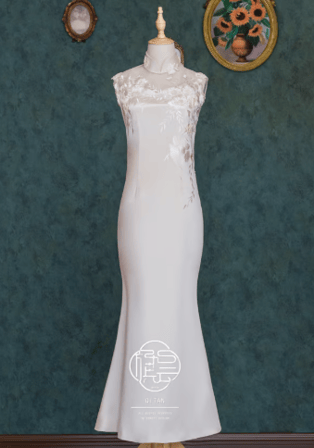How to Wash a Qipao Without Damaging It
Whether it is exquisite silk, satin cheongsam or modern blended materials, careful maintenance can make it maintain its shape, luster and exquisite details for a long time.
QIPAO KNOWLEDGE
6/14/20252 min read


Understanding the Fabric First
Before attempting to clean your qipao, take a close look at the material. Most traditional qipaos are made from silk, satin, or embroidered fabrics, all of which are sensitive to friction, heat, and strong detergents. Modern qipaos may contain synthetic blends that are more durable, but they still deserve care.
Check the care label inside the dress if available. If it states "Dry Clean Only," do not attempt hand or machine washing. For handmade or customized qipaos (such as from Xiaochi Qipao), it’s safest to follow the designer’s specific cleaning advice.
Hand Washing Silk or Satin Qipao
If your qipao can be hand-washed, fill a basin with cold or lukewarm water. Add a small amount of mild detergent formulated for delicate fabrics or silk. Do not use bleach or strong soap. Gently submerge the dress and swish it in the water without rubbing, scrubbing, or twisting. Soak for only a few minutes.
Rinse thoroughly in cold water to remove all soap. Support the garment fully when lifting it out of the water to avoid stretching the fabric or seams.
Drying Your Qipao Properly
Never wring out a qipao. Instead, lay it flat on a clean towel, roll it gently to absorb excess water, then unroll and reshape it. Dry it flat on a second clean towel in a shaded, well-ventilated area — avoid direct sunlight, which can fade colors and damage fibers.
Avoid using a tumble dryer or hanging the qipao by its shoulders while wet, as this can distort the garment’s structure and form.
Ironing and Storage Tips
If ironing is needed, turn the dress inside out and use the lowest heat setting. Place a pressing cloth between the iron and fabric to prevent scorch marks or shine. Steamers are safer for silk and embroidered fabrics, offering a gentle wrinkle removal option.
When storing a qipao, keep it in a breathable garment bag. Avoid plastic covers, which can trap moisture and encourage mildew. If hanging, use a padded hanger to maintain the shoulder shape; for heavier fabrics, consider storing flat.
When to Use Professional Cleaning
If your qipao includes beading, metallic threads, or extensive embroidery, hand washing could do more harm than good. In these cases, it’s best to consult a professional dry cleaner — ideally one familiar with traditional garments. For valuable, heirloom, or heavily soiled qipaos, dry cleaning is the safest option.
Caring for a qipao the right way ensures it remains a cherished part of your wardrobe — timeless, elegant, and ready for the next occasion. Whether you own a ready-to-wear piece or a bespoke creation from Xiaochi Qipao, understanding how to wash and preserve it is a small effort that protects a beautiful legacy.
If you'd like to explore more topics like how to store a qipao for long-term preservation or what to wear under a qipao, I can create articles that help build a strong SEO content base for your brand or blog.
A qipao, also known as cheongsam, is more than just a dress — it's an elegant representation of Chinese heritage, craftsmanship, and personal grace. Whether it’s made of delicate silk, brocade, or modern blended fabrics, caring for a qipao properly ensures it retains its shape, sheen, and intricate details for years. Washing a qipao isn’t like throwing a T-shirt into the laundry — it requires thoughtful handling.


